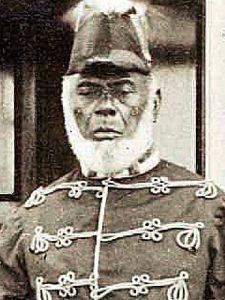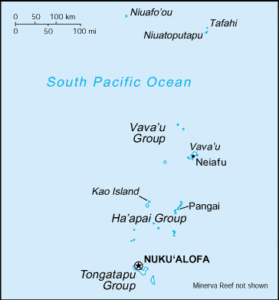
Tonga became a protected state under a Treaty of Friendship with Britain on 18 May 1900, when European settlers and rival Tongan chiefs unsuccessfully tried to oust the man who had succeeded Tāufaʻāhau as king. The treaty posted no higher permanent representative on Tonga than a British Consul (1901–1970). Under the protection of Britain, Tonga maintained its sovereignty, and remained the only Pacific nation to retain its monarchical government. The Tongan monarchy follows an uninterrupted succession of hereditary rulers from one family.
The 1918 flu pandemic, brought to Tonga by a ship from New Zealand, killed 1,800 Tongans: a mortality rate of about eight percent.[20]
The Treaty of Friendship and Tonga’s protection status ended in 1970 under arrangements that had been established by Tonga’s Queen Salote Tupou III before her death in 1965. Owing to its British ties, Tonga joined the Commonwealth in 1970 (atypically as a country that had its own monarch, rather than being ruled by the United Kingdom’s monarch), along with Malaysia, Lesotho, and Eswatini (Swaziland). Tonga became a member of the United Nations in September 1999. While exposed to colonial pressures, Tonga has always governed itself, which makes it unique in the Pacific.
Geography:
Located in Oceania, Tonga is an archipelago in the South Pacific Ocean, directly south of Samoa and about two-thirds of the way from Hawaii to New Zealand. Its 169 islands, 36 of them inhabited,[1] are divided into three main groups – Vava’u, Ha’apai, and Tongatapu – and cover an 800-kilometre (500-mile)-long north–south line.

The largest island, Tongatapu, on which the capital city of Nukuʻalofa is located, covers 257 square kilometres (99 sq mi). Geologically the Tongan islands are of two types: most have a limestone base formed from uplifted coral formations; others consist of limestone overlaying a volcanic base.
Economy:
Tonga’s economy is characterized by a large non-monetary sector and a heavy dependence on remittances from the half of the country’s population who live abroad (chiefly in Australia, New Zealand and the United States). The royal family and the nobles dominate and largely own the monetary sector of the economy – particularly the telecommunications and satellite services. Tonga was named the sixth most corrupt country in the world by Forbes magazine in 2008.
The manufacturing sector consists of handicrafts and a few other very small scale industries, which contribute only about 3% of GDP. Commercial business activities also are inconspicuous and, to a large extent, are dominated by the same large trading companies found throughout the South Pacific. In September 1974, the country’s first commercial trading bank, the Bank of Tonga, opened.
Tonga’s development plans emphasize a growing private sector, upgrading agricultural productivity, revitalizing the squash and vanilla bean industries, developing tourism, and improving communications and transport. Substantial progress has been made, but much work remains to be done. A small but growing construction sector is developing in response to the inflow of aid money and remittances from Tongans abroad. In recognition of such a crucial contribution the present government has created a new department within the Prime Minister’s Office with the sole purpose of catering for the needs of Tongans living abroad. Furthermore, in 2007 the Tongan Parliament amended citizenship laws to allow Tongans to hold dual citizenship.
